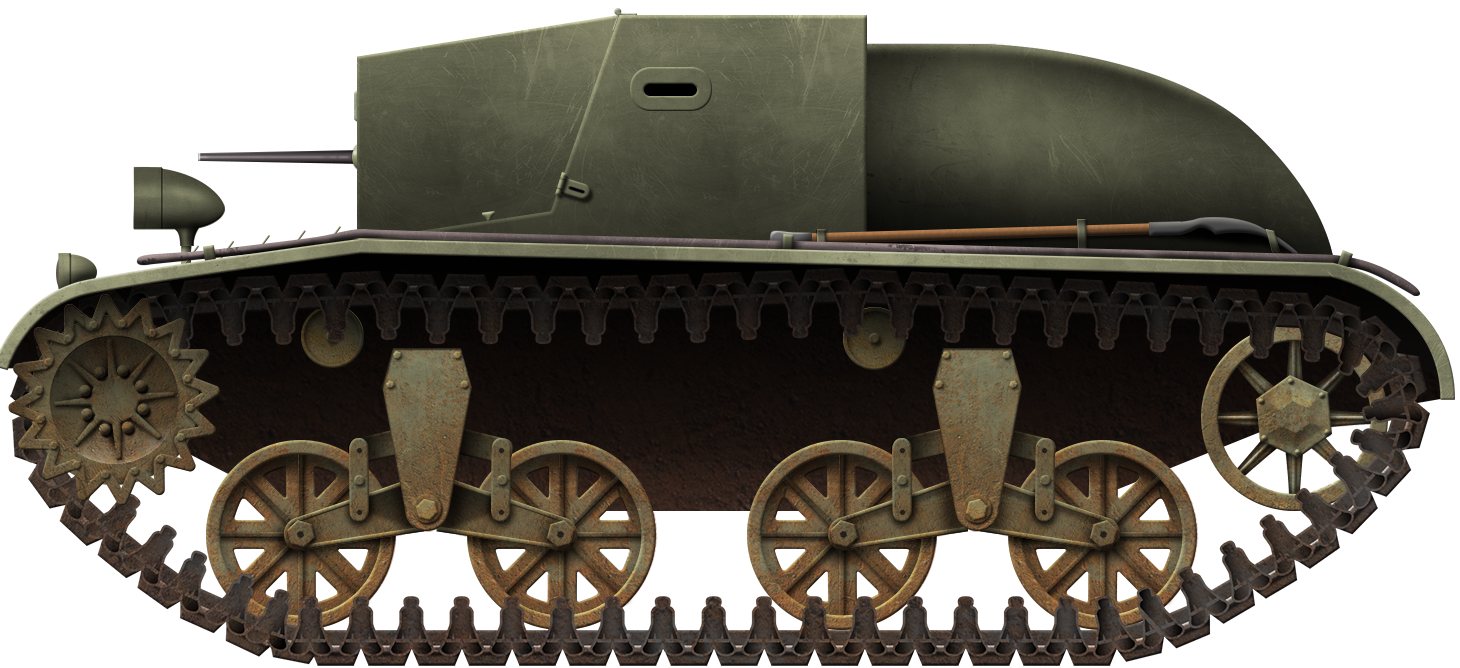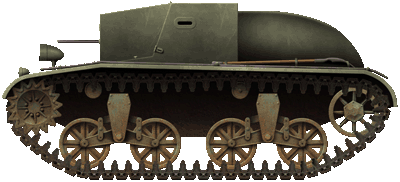 United States of America (1936)
United States of America (1936)
Light Tank – 1 Prototype Built

The Light Tank T3, made in the late 1930s, occupies a period of time in US tank development history best described not so much as a dark age but more of a grey age. Lots of failed and somewhat obscure ‘T’ number designs were being developed to fulfill an unclear and poorly considered set of strategic goals at a time when an isolationist America was unprepared to wage a modern war.
This relatively unknown and obsolete-before-it-was-even-finished tank is remarkable only for its unremarkableness, and that it was inferior in almost every way to tanks of other nations such as Italy, whose 2-man turretless light tanks were also identified as having serious failings in combat. Perhaps, the only thing to distinguish the Light Tank T3 is that it marks one small step in the process of development which eventually led to one of the most successful light tanks of WW2, the Stuart.
The design
The US Light Tank T3 started life in 1936 as an idea by Rock Island Arsenal (RIA) to produce a tank lighter than the Light Tank T2, which was due to go into mass production that fiscal year. At this time, weight was king. The US Secretary of State for War had decreed in the Spring of 1933 that 7.5 US tons (6.8 tonnes) was the maximum weight allowable for a light tank, so the goal was to keep the weight as low as possible. RIA had already dropped the British Vickers 6-ton-style suspension in favor of a double-wheel volute spring bogie from the Combat Car T5 for the Light Tank T2 in 1934. Thus, the suspension which was to form the basis of numerous American designs for the next several years had already been selected when the Light Tank T3 came along. With an attempt to be less than half the fully laden weight of the already light Light Tank T2 (weighing just 7.5 US tons to 9.7 US tons/6.8 to 8.8 tonnes depending on the variant), severe design compromises would have to be made.
The most obvious of these changes was the removal of the turret, followed by a significant overall reduction in size and the switch to a crew of just two instead of four on the Light Tank T2. The two crew were simply the driver on the front left of the hull, and the commander on the front right. The commander also had to operate the sole armament. In an effort to further reduce weight, some aluminum components were also used inside. Finished in March 1936, the vehicle was shipped to Aberdeen Proving Ground (APG) in Maryland in April that year. Here, on 23rd April, the Light Tank T3 was unveiled for comparative testing with the pilot model Combat Car T5 (a tank in all but name).


Engine
The Light Tank T3 was powered by a single V8 Ford car engine. Capable of delivering 83 hp at 3,800 rpm, with differential steering and a 4-speed transmission, the Light Tank T3 could manage a credible 35 mph (56 km/h) on a road.
This Ford V8 was later replaced with a Menasco air-cooled engine and as such was renamed Light Tank T3E1.
Suspension
The Light Tank T3 used a pair of dual-wheel bogies with rubber volute springs of a very similar style fitted to a whole generation of US tanks in WW2. These volute spring units, however, were the result of comparative testing with an experimental rubber torsion suspension. Details on what that suspension actually looked like are unclear but it is known that it failed repeatedly during testing and would need redesigning to be usable. It was not and was abandoned. When the Light Tank T3 was upgraded with a Menasco engine as the Light Tank T3E1, the volute springs were finally selected as the preferred suspension.
The Armament
The Light Tank T3 was very poorly armed, just a single .30 caliber (7.62 mm) machine gun located in the front right of the hull. Mounted in a ball, the range of motion was acceptable but still ultimately as limited as other vehicles such as the Italian CV.3, it faced forwards so could not fire to the sides or rear.
Armor
As might be imagined in such a small and light vehicle, the armor was woeful. No part of the Light Tank T3 was thicker than ⅜” (9.5 mm), with most of the armor being just 3/16” (4.8 mm) thick, enough to protect against small arms from the front but vulnerable to even a burst from a machine gun or shot from an anti-tank rifle. With such poor armor, it is no surprise that an idea was floated to increase the armor thickness to an unspecified value in another variant known as the Light Tank T3E2, with the issuing of the tank to the National Guard in mind. This was never completed and the Light Tank T3E2 was never built. There was also a T3E3 version that got as far as a study but it is not known exactly what the study was about and whether it was armor or automotive related or something else.

Variants
T3E1: upgraded T3 with a Menasco engine. 1 converted.
T3E2: T3 project with increased armor. None built.
T3E3: unknown study project
Conclusion
When the Light Tank T3E1 was abandoned, it was not wasted. Instead, the remaining vehicle was stripped of its armament and converted into an experimental tracked carrier named the Cross-Country Carrier T5. The sole contribution of the Light Tank T3 is perhaps to show the futility of a two-man tank armed with just a single machine gun. The cost of the vehicle and the poor combat potential meant that, despite moderately good mobility, it was still a failure. Of the variants attempted, the Light Tank T3E1 was at least an improvement with a better engine but the E2 with more armor was dropped before it began. The Light Tank Tank T3E3 got as far as a design study but how far and quite what they were even trying to study is not clear. The concept was a dead end. The vehicle was converted to a tracked utility carrier and quite rightly consigned to the dustbin of US tank design.


Specifications |
|
| Dimensions | 11.25’ x 6.75’ x 4.5’ (3.43 x 2.06 x 1.37 m) |
| Weight | 3.54 US tons / (3.21 tonnes) |
| Crew | 2 (Commander/gunner, and driver/radio operator) |
| Engine | Ford V8 Petrol (T3), Menasco air-cooled (T3E1) |
| Max. speed | 35 mph (56 km/h) |
| Armament | 1 x .30 caliber machine gun |
| Armor | ¼” to ⅜” (6.35 to 9.53 mm) (T3), slightly heavier armor (T3E2) |
Sources
AFV Data Series
Crimson, F. (1992). US Military Tracked Vehicles. Crestline, USA
United States Army. The General Staff: Its Origins and Powers
AGF Board. (1947). Development of Armored Vehicles Vol.1: Tanks.
Hunnicutt, R. (1992). Stuart: A History of the American Light Tank. Presidio Press, USA

